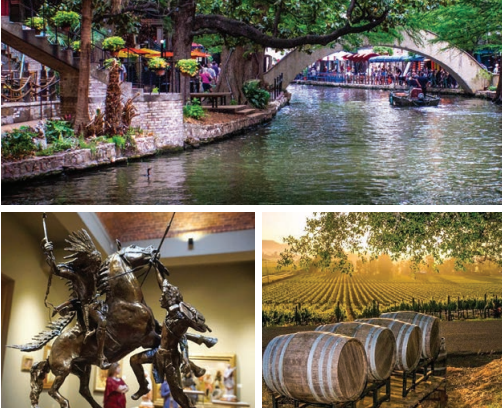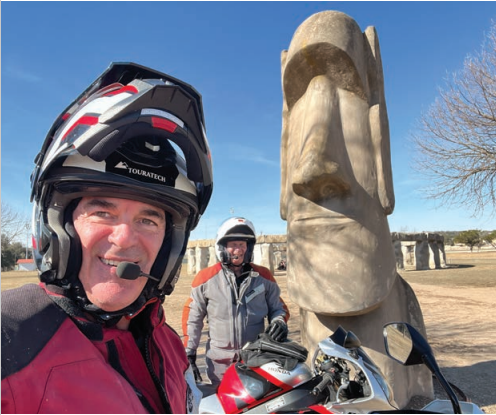By Todd Nunnally
We Texans are excited about hosting STAR in the beautiful Texas Hill Country. You are in for a special treat. Your Kerrvillian scooter colleagues and the surrounding area plan to send ya’ll regular teasers on the MSTA forum. So, stay plugged-in to get the most from your visit in 2024. Aside from the scenic, breathtaking views of rolling hills, the river running right through downtown, and its beautiful parks, Kerrville has much to offer.
Nestled along the banks of the Guadalupe River, you will discover a vibrant, welcoming community of people who are proud of their heritage, have a keen sense of community and have fantastic roads that attract motorcyclist and car clubs from far and wide. Kerrville locals are proud of their heritage and welcome guests to share it, offering experiences like live music, festivals, art museums, and crafts fairs, all in a serene setting. Close to charming Fredericksburg and its great wineries and an hour from San Antonio’s famous Riverwalk, fun is not in short supply. Here are some teasers for you!

Bring your credit card! One of the most recognizable jewelry brands in Texas, James Avery Craftsman, was founded in Kerrville over 60 years ago. Its visitor center welcomes guests to learn about the history of the family-owned company, the crafting of their distinctive jewelry, and James Avery himself. The Riverside Nature Center has a little bit of everything for people interested in learning about and exploring nature. Located at the confluence of the Guadalupe River and Town Creek, it is a natural wildlife habitat and includes several gardens and educational areas.
Need a pint? Head to Pint & Plow Brewing. This spot prides itself on being a welcoming community space in addition to the city’s first craft brewery. With a full kitchen and espresso bar, you could spend all day hanging out on its charming patio. Want some German/Texas history? Commissioned by Captain Charles Schreiner as a two-story, six-bedroom home, the turreted Schreiner Mansion, which has many European influences, was designed by architect Alfred Giles and built by expert German masons. Listed on the National Register of Historic Places, the mansion is worth a tour. Sunrise Antique Mall is a shopper’s dream. It’s easy to lose yourself among the vintage advertising, rare stamps, jewelry, and collectibles. The antique mall has numerous vendors with different specialties ranging from furniture to coins and vinyl records. You never know what unique items you’ll find here.
In downtown, the 64-acre Louise Hays Park is a peaceful place to get outside. Located on the Guadalupe River, the park includes a 2.4-mile River Loop trail and Tranquility Island, a seven-acre island in the middle of the river lined with gorgeous Cypress trees. Trek far enough and you will find yourself consuming another pint at the Trailhead Beer Garden.
Kerrville has a thriving theater scene thanks to Playhouse 2000. Year round, there are musicals, plays in the black box theater, and productions of Shakespeare in the park. You might find anything from community theater productions to touring musical groups from around the country. The outskirts of town are home to two of the unique roadside curiosities in Texas—replicas of both Stonehenge and the distinctive Easter Island stone heads. Constructed by artist Al Shepperd and his friend Doug Hill in the 1990s, this attention-getting Stonehenge II (locals fondly call it Bubbahenge) is about 90% as wide and 60% as tall as the original in England. The 13-foot tall replica stone heads came later after Shepperd was inspired by a trip to Easter Island. The artificial stones can be found on the Hill Country Arts Foundation campus.

The paintings, drawings, and sculptures at the Museum of Western Art tell the stories of the Wild West and the American frontier. The museum focuses on the work of living Western artists while temporary exhibits highlight masters of the past, artifacts, and history. Designed by Texas architect O’Neil Ford in 1981, the museum building itself is a work of art resembling a fortressed hacienda.
Buzzie’s BBQ is the best barbecue spot in town and, according to Texas Monthly, one of the top 30 in the state. For 25 years, pitmaster Harold “Buzzie” E. Hughes has made perfectly smoked meats in the rustic space on Schreiner Street. One of the must-visit attractions in Kerrville, the Kerr Arts and Cultural Center is a hub of creativity in the city. Its galleries host over 40 exhibitions each year covering a wide variety of arts from Texas furniture to watercolor paintings to sculptures and historical photography.
Kerrville doesn’t lack for beautiful places to get outside and appreciate nature, and the Kerrville-Schreiner Park is one of the best. With 517 acres on the Guadalupe River, it’s the ideal location for kayaking and canoeing most of the year. There are also biking and walking trails, picnic areas, and camping opportunities, if you want to stay for a while.
Kerr County History and Climate
STAR participants will be riding in a region that has been the site of human habitation as early as 10,000 years ago. Before the area was settled, the Lipan Apache, Comanche and Kiowa hunted in the region. And there are many places for you to visit and consume history and calories! In 1689, Alonso De Leon, Spanish explorer and governor, discovered a river of rare beauty lined with giant cypress, native walnut and pecan trees. The river rose in the western hills and had cut a channel through layers of limestone. De Leon named the river “Our Lady of Guadalupe.” The Guadalupe rises from springs in the northwest part of Kerr County and flows 255 miles to the Gulf of Mexico.
During the mid-eighteenth century, Spanish military units traversed the area defending San Antonio from Apache. In 1844, Joshua D. Brown became interested in the making of cypress shingles and led a party of ten men up the Guadalupe River and selected a site near what is now the 900 block of Water Street in Kerrville. The Apache drove Brown and his men from the area, but they returned in 1848 naming their settlement Brownsborough. In 1856, Kerr County was formed from the former Spanish Bexar Land District and the name changed to Kerrsville, for Brown’s friend and fellow veteran of the Texas Revolution, Major James Kerr. Later the “s” was dropped, and the town became “Kerrville.”
In 1857, A German master miller Christian Dietert and millwright Bathasar Lich started a large grist and sawmill on a bluff next to the Guadalupe River that became the most extensive operation of its kind west of San Antonio. Related mercantile and freighting enterprises led to the foundation of the Charles Schreiner family empire of retail, wholesale, banking, ranching, marketing and brokering operations. Kerrville began to prosper with the end of the Civil war and as Indian raids ceased. Early settlers established successful sheep, cattle and goat ranches in the area. Cattle drives punctuated the boom years of the late 1880s and 1890s. In 1887 The San Antonio and Aransas Pass Railway reached Kerrville.
Kerrville survived recessions and the Great Depression far better than many towns. Wealthy and diversified even in the 1920s and 1930s, the town rapidly surpassed many of its neighbors economically and became a regional transportation, banking and medical center for the western Hill Country and Edwards Plateau. The town’s reputedly healthful climate, its wildlife and scenery gave rise to tourism
that at first included mainly middle-class San Antonians and Austinites. After the 1940s the area attracted a new generation of postwar “living city but thinking and singing country” Texans. From tubercular sanctuary to home of “Blue Yodeler” Jimmie Rodgers, Kerrville had grown by the 1950s to a tidy town with distinctive flair and personality. By the mid-1990s the Wall Street Journal described Kerrville as one of the wealthiest small towns in America.
Camp Verde
While most frontier Army posts of pre-Civil War days were preoccupied with Indians, Camp Verde, 14 miles south of Kerrville, was involved with one of the most remarkable military experiments ever conducted by the US Government. In 1854, Secretary of War Jefferson Davis, petitioned Congress to appropriate $30,000 so the Army could experiment with camels for army transportation and military purposes. In 1856, the first shipment of 33 Bactria and Smyrna camels was landed at Indianola, Texas and walked to Camp Verde via Victoria and San Antonio – a curious parade for residents along the route. A second shipment of 40 beasts made the trip later. The third shipment, used as a cover for slave importation into the United States, was turned loose to range the coastal country.
Center Point
Center Point was first called Zanzenberg, after a relative of Dr. Charles Ganahal, who was one of the earlier people to settle the area. In 1859 the name changed to Center Point because the settlement was halfway between Fredericksburg in Gillespie County and Bandera in Bandera County. The settlement was also the halfway point between Kerrville, in Kerr County, and Comfort, in Kendall County. By 1875 Center Point was a thriving community and was larger than Kerrville.
The area’s potential as a farming and stock-raising center, its healthful climate, and its abundant game continued to attract settlers. Virginia Jordan (Wright) de Ganahl, Charles Ganahl’s widow, deeded 200 acres to the San Antonio and Aransas Pass Railway in 1888. She hoped to draw the center of population back to the north side of the river around a community to be called Ganahl. Although the community never developed, the Ganahl depot, located a mile north of central Center Point, ensured the town’s position as a trade center for the surrounding region.
Center Point held its position as area trade center until the 1920s, when the paved highway skirted the edge of town and surrounding towns developed their own transportation facilities. The town maintained a stable population and business community throughout succeeding years. Much like other towns in scenic Kerr County, Center Point has several small service and manufacturing businesses and attracts a steady stream of vacationers, retirees, and summer residents.
STAR (Sport Touring Association Rendezvous) will take place this coming October 19-24, 2024
